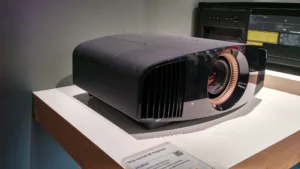Sony announced a new home theater projector to its ES line at CEDIA. The VPL-VW675ES offer native DCI 4K resolution (4096 x 2160) and HDR support for HDR10 and Hybrid Log Gamma (HLG) – its first to support HLG. It succeeds the VPL-VW665ES.
The HLG support will come later in the year once new HDMI specifications are released. Sony is waiting for the new HDMI 2.1 specification to be officially released which is expected to include signaling for HLG. While no metadata needed to be carried with HLG, the content stream needs to include a flag to alert the display that the content is HLG-based. This flag will be carried in the InfoFrame component of the HDMI signal.
In the meantime, HDMI 2.0b version has been released. This includes an expansion of the audio formats as well as support for an 8-bit HDR10 signal. Presumably, this is designed to allow legacy HDMI connections with the lower 10.2 Gbps bandwidth to transmit HDR signaling.
The VW675ES will have an HDMI 2.0a connection that will be firmware upgraded to 2.1.
One of the issues with HDR and projection solutions is the low peak luminance levels that are achievable. Projectors have a lumen output rating but to compute the reflected screen luminance, you need to know the screen size and gain. With a gain screen, this luminance will vary with viewing angle as well. Typical home theater set ups are going to produce peak luminance level that may be 100-200 cd/m² – far lower that the premium flat panel TVs that offers 500 to 1800 cd/m².
Solving some SDR/HDR Issues
The impact of this is that the overall brightness of the HDR content can appear dimmer than an SDR version, which does not use the PQ EOTF curve. To address this, Sony has added a feature which enables customers to adjust the average screen brightness, depending on their environments or preferences, while maintaining accurate HDR reproduction. This is essentially a tone mapping adjustment of the midtone level of the image. This feature, along with HLG support, will be implemented on the 675ES and the 5000ES models.
This new projector is also lamp based but has some new driver technology to enable a lamp lifetime to 50% brightness of 6,000 hours (in Low mode). Overall, it delivers 1800 lumen, but it is unclear what mode the projector is in for that measurement. Normally, a cinema or movie mode will be calibrated for 709 or P3 and will have lower lumen output. Sony does not provide details on their color gamut other than to say it meets Sony’s Triluminos standard. This is in between rec. 709 and the DCI-P3 color gamut, we were told.
Sony was also stressing the “native 4K” resolution of the projector and comparing it to other “e-shifted” types that offer fewer pixels (see more on this in the shoot-out article). And, we were told that Sony’s Reality Creation engine was improved somewhat as well. This is not simply a scaler and edge enhancement or sharpening engine. The processor supposedly looks at the content to identify its type, then applies an algorithm to create more detail that was in the original. This can mean adding more crispness to beard stubble to the texture of sushi or a knife blade. Sony also said that it will ignore noise in the sky or dark areas and not enhance them, which is a good thing. However they do it, it does work.
Dynamic contrast is rated at 350,000:1 which means the unit has an iris that can adjust the light output based on the average brightness of the scene. This can help enable an HDR-like image, but it is only global (0-D) dimming. Edge-lit LCD displays can do 1-2-D dimming and direct backlight LCD can do 2D dimming. OLED display can essentially do pixel-level dimming as they are emissive.
Designed for Installers
Installers can also take advantage of Projector Calibration Pro software on HD through 4K Sony home theater models, allowing them to manipulate all of a projector’s features from a PC interface, including the sophisticated color calibration tools. Setup configurations can be saved to a file to upload to any future installations, making future calibrations that much quicker.
In addition, there is a light sensor that measures the spectral profile of the lamp at the factory and saves it in memory. This can be checked periodically as the lamp ages to see how the spectral profile is changing. A reset button will then reset color correction setting based on the changed profile to restore it to the factory look. If the projector was calibrated, those settings would be applied on top of this and restore the projector to a near calibrated state.
Sony also corrected some logic in the HDR decoding. The company said that they were assuming that all incoming content would have colors placed in the BT.2020 container and would use 2020 color coefficients. It turns out that that was an incorrect assumption as some HDR content is delivered using rec 709 coefficients. This resulted in images that were too red. To fix this, the decoder now looks to the data in the InfoFrame part of the HDMI signal that contains the mastering color information. If it finds this data, it can adjust the projector correctly and if it is missing, Sony now assumes a rec 709 color gamut and coefficients.
Sony had a ‘shoot out’ using this projector (Sony 4K Projector Shoot-Out Result Unclear)
The VPL-VW675ES home theater projector will be available in November 2016 at an MSRP of $14,999.99. –CC

